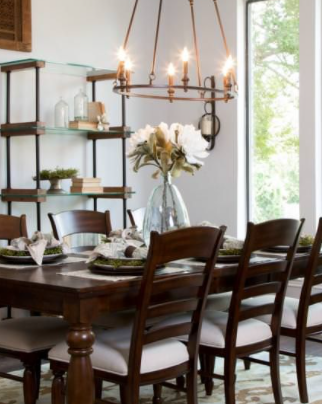Although there are no difficult and easy rules, there are a few guidelines suggested by home remodeling company Lake Elmo, MN that will help you decide the correct size for the chandelier in your dining room:
 Tips for choosing the size of chandeliers in dining rooms
Tips for choosing the size of chandeliers in dining rooms A dining room chandelier should have a diameter of around one-half to two-thirds of the width of the table from which it will hang. Another version of this rule is that the diameter of the fixture at its widest point should be around 1 foot smaller in diameter than the width of the dining room table. The reasoning behind these guidelines is that if the hanging fixture is well held back from the seating area, visitors rising from their seats are less likely to knock their heads. If this is not feasible, most experts claim it's easier to go bigger rather than smaller with the chandelier size of the dining room. The fixture can still be hung a little higher, so it's well out of the way.
If appropriate, scale the chandelier so that every wall or other piece of furniture is no closer than 48 inches from it. Although difficult to do in smaller spaces, this is a reasonable rule-of-thumb to bear in mind.
Foyers and Other Room tips
Bear in mind that a suitable chandelier is more than a question of scale for foyers, great rooms, and other large spaces. Note that the style of the fixture and visual weight also play a part. It can be a little smaller if you pick a fixture with a heavy, ornate theme, while a more delicate fixture can afford to be a little wider than the rules suggest.
Adding the length and width measurements of the space together, measured in feet, is one common approach for deciding the correct size for a chandelier. For your chandelier, that amount, in inches, is a good size. A foyer 12 feet x 12 feet in size, for example, calls for a chandelier fixture with a 24-inch diameter.
These principles are followed by certain designers, which provide a little more flexibility:
Find a chandelier that's 17 to 20 inches tall for rooms smaller than 10 feet x 10 feet.
Choose a chandelier that is 22 to 27 inches tall for rooms about 12 feet x 12 feet.
Find a chandelier that is 24 to 32 inches tall for rooms about 14 feet x 14 feet in size.
Rooms larger than this, unless their ceilings are very high, seldom need chandeliers larger than 32 inches tall. Very large rooms can tolerate a chandelier as much as 36 inches in diameter with ceilings 14 feet or higher.